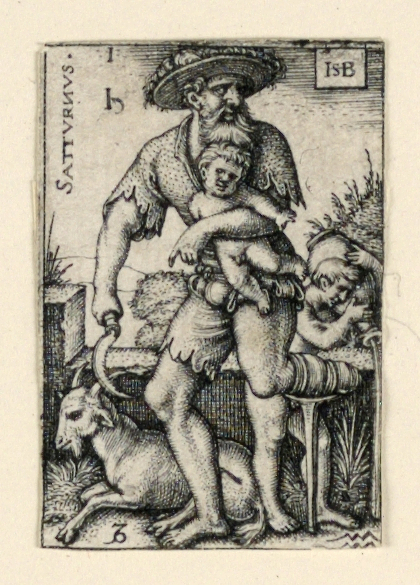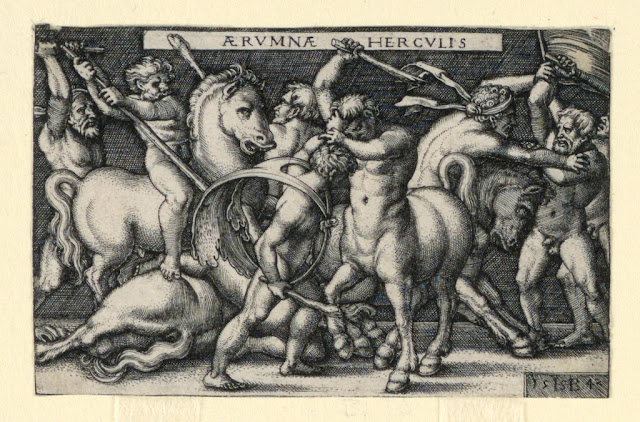 |
| Sebald Beham Title-page - The Seven Planets Sun, Moon, Mars, Mercury, Jupiter, Venus, Saturn 1539 engraving Cooper Hewitt, Smithsonian Design Museum |
 |
| Sebald Beham The Seven Planets - Sun 1539 engraving Cooper Hewitt, Smithsonian Design Museum |
 |
| Sebald Beham The Seven Planets - Moon 1539 engraving Cooper Hewitt, Smithsonian Design Museum |
 |
| Sebald Beham The Seven Planets - Mars 1539 engraving Cooper Hewitt, Smithsonian Design Museum |
 |
| Sebald Beham The Seven Planets - Mercury 1539 engraving Cooper Hewitt, Smithsonian Design Museum |
 |
| Sebald Beham The Seven Planets - Jupiter 1539 engraving Cooper Hewitt, Smithsonian Design Museum |
 |
| Sebald Beham The Seven Planets - Venus 1539 engraving Cooper Hewitt, Smithsonian Design Museum |
 |
| Sebald Beham The Seven Planets - Saturn 1539 engraving Cooper Hewitt, Smithsonian Design Museum |
" . . . Ptolemy describes a universe in which each planetary 'shell' is contiguous with that of the bodies immediately above and below it. This system allowed him to compute the absolute dimensions and distances of all parts of the universe out to the sphere of the fixed stars, which he found to be less than 20,000 earth-radii from the central earth (less than the distance from the earth to the sun by modern computation). This vision of a small and completely determined universe, although not universally accepted even in late antiquity, became the canonical view of the Middle Ages, in both east and west, and is enshrined in biblical exposition and learned poetry as well as in the works of professional astronomers. It was a strong argument against consideration of the heliocentric hypothesis, which entailed a vastly larger universe in which the fixed stars were at enormous distances."
– from the article Astronomy in The Oxford Classical Dictionary (3rd edition), edited by Simon Hornblower and Antony Spawforth (Oxford University Press, 1996)
"From a modern perspective it is the postulated link, causal or semiotic, between celestial and terrestrial events that renders astrology suspect. Most ancients took that link for granted, under a belief in a 'universal sympathy' which connects all parts of the cosmos in a harmoniously functioning whole. Stoicism legitimized divination of all sorts; and the worship of the stars, especially the sun, added further authority to astrology, as did the common belief in the soul's celestial origin and destiny. Many intellectuals accordingly accepted and justified the art, including Ptolemy, who makes a well-reasoned case that astrology is but the application of astronomy, in a necessarily fallible way, to the sublunary environment."
– from the article Astrology in The Oxford Classical Dictionary (3rd edition), edited by Simon Hornblower and Antony Spawforth (Oxford University Press, 1996)
 |
| Sebald Beham Hercules Abducting Iole 1544 engraving Cooper Hewitt, Smithsonian Design Museum |
 |
| Sebald Beham Hercules Battling the Trojans 1545 engraving Cooper Hewitt, Smithsonian Design Museum |
 |
| Sebald Beham Hercules Battling the Centaurs 1542 engraving Cooper Hewitt, Smithsonian Design Museum |
 |
| Sebald Beham Hercules Slaying Nessus 1542 engraving Cooper Hewitt, Smithsonian Design Museum |
CENTAURS – A tribe of beasts, human above and horse below; the wild and dangerous counterpart of the more skittish satyrs, who are constructed of the same components but conceived as amusing rather than threatening creatures. In both cases it is the very closeness of the horse to humanity that points up the need to remember that a firm line between nature and culture must be drawn. Pirithous the king of the Lapiths, a Thessalian clan, paid for his failure to absorb this lesson when he invited the Centaurs to his wedding feast; the party broke up in violence when the guests had tasted wine, that quintessential product of human culture, and made a drunken assault on the bride. 'Ever since then,' says Antinous in the Odyssey, 'there has been conflict between centaur and man.' Their uncontrolled lust, violence, and greed for alcohol challenge the hard-won and ever-fragile rules of civilization, which are symbolically reasserted by the victories of Hercules (whose wife Dejanira the Centaur Nessus tried to rape) . . .
– from the article Centaurs in The Oxford Classical Dictionary (3rd edition), edited by Simon Hornblower and Antony Spawforth (Oxford University Press, 1996)
 |
| Sebald Beham Hercules and the Nemean Lion 1542 engraving Cooper Hewitt, Smithsonian Design Museum |
 |
| Sebald Beham Hercules on the Pyre 1548 engraving Cooper Hewitt, Smithsonian Design Museum |